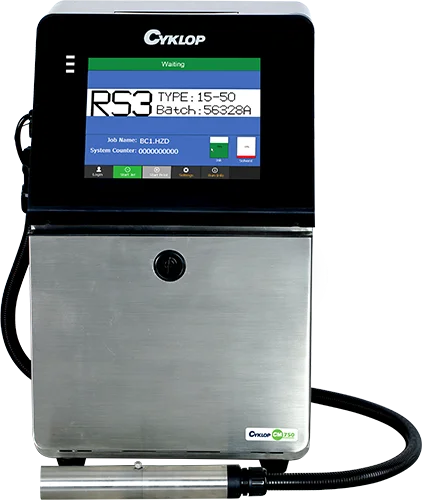What is an Inkjet Printer?
A flexible and important printing tool, inkjet printers are used to mark and code numerous kinds of packaging and goods. In order to print text, graphics, logos, barcodes, and other information directly onto packaging surfaces, the technique uses the principle of projecting tiny droplets of ink onto a substrate.
- Capabilities for coding and marking: Batch numbers, expiration dates, barcodes, logos, and other important data can be printed directly on package materials using inkjet printers.
- Options that are environmentally friendly: Some inkjet printers include ecologically friendly inks with lower volatile organic compound (VOC) levels and other green characteristics.
- Fast-drying inks and long-lasting inks: Printers with quick-drying inks guarantee that codes remain legible and undamaged for packages subjected to adverse conditions (such as moisture or temperature changes).
- Printing at a High Speed: High-speed printing is necessary on some packaging lines to keep up with production rates. Inkjet printers that print quickly can meet these needs.
- Compatible Ink: For use with both porous and non-porous packaging materials, inkjet printers provide a variety of ink options. Examples of inks that can offer strong adhesion and endurance on various substrates include UV-curable, solvent-based, and water-based inks.
- Printing with variable data is frequently necessary to customize packaging with elements like barcodes, QR codes, batch numbers, expiration dates, and information particular to a given product. Because inkjet printers are so good at providing variable data, it is possible to customize packaging for various items, batches, or clients.
- Time-to-market is crucial in the field of packaging, which moves quickly. Due to their high printing speeds, inkjet printers help package companies fulfil deadlines and react to shifting packaging specifications.
- The non-contact printing method used by inkjet printers is beneficial for fragile or delicate packing materials. This prevents the possibility of the packaging being harmed during the printing process and preserves the quality of the final product.
- Inkjet printers are generally simple to integrate into current packaging production lines. Through less manual involvement and improved procedures, this integration increases productivity.
- Print Speed and Throughput: Production effectiveness is crucial in the quick-moving packaging sector. Examine the throughput capacity and print speed of the inkjet printer before making your purchase. The printer should be able to process the quantity of packing materials you need within the durations you need. To fulfil deadlines and maintain a smooth production flow, high-speed printers are often used. This increases operational effectiveness overall.
- Print Resolution and Quality: Consumer satisfaction and brand perception are significantly impacted by the print quality of information on packing materials. To print legible barcodes, text, logos, and graphics, make sure the inkjet printer you're thinking about has the print resolution you need. When dealing with tiny letter sizes or delicate design components, high print resolution is especially important. To ensure consistent results, check the output quality of the printer on various packaging substrate types.
- Compatibility with Substrates: Packaging materials range significantly in compatibility with substrates, from paper and cardboard to plastic films and labels. Choosing an inkjet printer that works with the exact substrates required for your packaging applications is critical. Make that the printer's ink sticks effectively to the selected substrates without smearing, fading, or affecting adhesion by conducting compatibility tests. For printed information to remain attractive and durable, this factor must be considered.
- Ink Formulation and Durability: Packaging materials frequently need to withstand a variety of environmental conditions, including moisture, UV exposure, and temperature changes. The inkjet printer's formulation of ink must be appropriate for the packaging environment. Inks that are resistant to UV rays, water, and solvents can assist guarantee that printed text is legible and clear for the duration of the life of the container. Consider the lifetime and durability of the printer's ink selections on various substrates.
- Maintenance and serviceability: To reduce downtime and guarantee continuous output, routine maintenance and prompt problem-solving are crucial. Choose an inkjet printer with straightforward maintenance instructions and comprehensive documentation. Moreover, consider the customer service and service availability provided by the printer manufacturer. The total dependability of the printer and your operational effectiveness can be greatly impacted by quick technical support response times and the availability of replacement parts.
INDIA Quotation
What is coding?
By means of industrial printing, or coding, you apply information such as text and numbers to a product or packaging. Multiple terms are used for this process, such as coding, printing or marking.
There are different ways of coding and printing has different applications and purposes. You can read more about these goals and applications below.
Why industrial printing?
Information is transferred by coding. This makes it possible to provide information directly to the user. For example, the best before date can be printed, but also contact details on a shipping box, or user instructions on a product or box.
Products can also be made recognizable by coding. Barcodes, QR codes or type numbers can improve the recognisability of individual products, boxes or pallets. These can all be printed.
Making a product traceable is an important goal of industrial printing. Think of coding batch codes, production data and other track & trace information on products. This information is important for manufacturers, but it does not in itself provide information.
How does coding work?
Coding of products and packaging can be done in several ways. The Cyklop printers can be divided into two technological categories: High Resolution Inkjet printing and Continuous Inkjet printing.
A high resolution inkjet printer can be used well when high print quality and ease of use are important. It is no problem to print 2D codes, barcodes, expiry dates (best before date), texts and logos in high resolution. Printing can be done on almost any surface with the right combination of printer and ink.
Continuous inkjet printers (or small character inkjet printers) are designed to code on almost any type of material, often at high speed. Printing is possible regardless of porosity, size, shape and texture. It is also no problem to print information such as best before data, text, batch codes and logos on individual products.
High Resolution Inkjet printing
High resolution inkjet printers use standard cartridges and do not require additional solvents. Replacing cartridges is very easy, and generally wiping the printhead and cartridge is the only maintenance that the system needs. The printers work by heat in the printhead. The ink is heated when something needs to be printed, causing it to expand. The ink is then ‘ejected’ through the openings (nozzles) in the printhead. For best results, the printer should be placed close to the product due to the limited flow distance of the ink.
Advantages of the high resolution inkjet:
- Excellent print quality on almost any surface
- Maintenance is easy
- User friendly
- Use of cartridges
- Easy to integrate in an automatic line or in / on packaging machines
Click here for the high resolution printers from Cyklop.
Continuous Inkjet printing
Continuous inkjet printers use ink and make-up liquid (thinner). Both liquids are in a separate container / bottle and are mixed in the ink reservoir to achieve the correct viscosity. The ink is fed from the ink reservoir into the print head under high pressure via the print hose. This head contains a resonator, an electronic element, which causes vibrations in the ink jet. This creates droplets, which are necessary for printing, which then leave the print head. In combination with the movement of product or printhead, a legible coding is applied to the material. The unused drops are returned to the reservoir via a return line, so that no unused ink is lost.
The main advantages of continuous inkjet:
- Suitable for coding on uneven surfaces
- High speed printing
- Contactless coding, longer distance to product is possible
- Change ink and make-up separately and easily
- Low cost per print
Click here for the CIJ printers from Cyklop.
Which method of industrial printing is most suitable?
Choosing the right printer is not always easy. Shape, print environment, speed, type of surface, what to print and the conditions to which the print is exposed play a role in making this decision.
We would of course like to help you with this! Please feel free to contact us for tailor-made advice.
Consumables
When printing with a high resolution inkjet printer, two types of ink are used: solvent ink and water-based ink. Solvent ink is suitable for printing on non-absorbent or non-porous materials such as plastic, metal and glass. Water based ink is suitable for printing absorbent or porous materials such as paper, cardboard and wood.
Fast drying ink and make-up fluid are used when coding with a continuous inkjet printer. Both liquids are in a separate container that can be replaced separately.
Click here for more information about cartridges and liquids.

